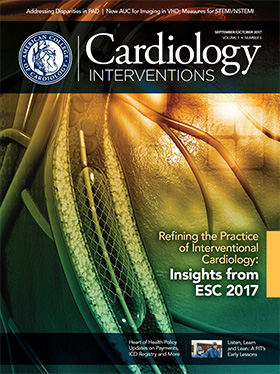Transcatheter patent ductus arteriosus (PDA) occlusion is one of the safest interventional cardiac procedures among adults and children. However, major adverse events are five to 10 times greater among infants who weigh less than six kilograms (kg), according to a study published in JACC: Cardiovascular Interventions.
Differences were examined across three weight categories: extremely low weight (ELW, <2 kg), very low weight (VL, 2-<4 kg) and low weight (LW, 4-<6 kg). A third of infants were born at <30 weeks of gestation. At catheterization, median age was 4.3 months and most were LW (4.6 kg). More than half of procedures were performed on females and Caucasians. Less than half of infants were hospitalized before the procedure and more than half were on diuretic treatment. Most infants had a Type A (37 percent) or Type C (42 percent) PDA.
While the majority of attempted PDA closures were successful, approximately 13 percent of infants experienced major adverse events (MAEs). “In the present cohort of infants <6 kg, procedural success rates for transcatheter PDA closure are similar to those in more mature counterparts, but rates of MAE were five- to 10-fold greater,” note the study authors.
Most common MAEs included acute arterial injury (3.5 percent) and device embolization (2.4 percent). ELW infants (10.5 percent) had a higher risk of embolization than VLW or LW infants (1.6 percent and 2.5 percent, respectively; p = 0.050). Other noted MAEs included arrhythmia requiring intervention, unplanned cardiac surgery and a major bleeding event (<2 percent each). Infants who experienced an MAE were more likely to stay at the hospital a week longer than those who did not (13 vs. 20 days, p = 0.01). Additionally, risk of MAEs (odds ratio [OR], 3.4; 95 percent confidence interval [CI], 1.5-7.9) and composite failure (OR, 3.1; 95 percent CI, 1.4-6.9) was higher among younger patients (<30 days).
While the study proves to be an “important first step in understanding the risk profile of transcatheter PDA occlusion in this subgroup of infants,” the authors note that “conclusions on the optimal treatment among lower weight infants with a persistent ductus remain unanswered.”
“Conservative treatment may reduce unnecessary interventions in many infants, but the question remains as to what to do if the PDA fails to close following a period of conservative treatment,” they continue. They call for well-designed comparative trials of transcatheter occlusion, surgical ligation and conservative treatment.
Backes CH, Kennedy KF, Locke M, et al. JACC: Cardiovasc Interv 2017; 10:1729-37.
<<< Return to top






